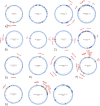Metagenomic assembly is the main bottleneck in the identification of mobile genetic elements
- PMID: 38188174
- PMCID: PMC10771768
- DOI: 10.7717/peerj.16695
Metagenomic assembly is the main bottleneck in the identification of mobile genetic elements
Abstract
Antimicrobial resistance genes (ARG) are commonly found on acquired mobile genetic elements (MGEs) such as plasmids or transposons. Understanding the spread of resistance genes associated with mobile elements (mARGs) across different hosts and environments requires linking ARGs to the existing mobile reservoir within bacterial communities. However, reconstructing mARGs in metagenomic data from diverse ecosystems poses computational challenges, including genome fragment reconstruction (assembly), high-throughput annotation of MGEs, and identification of their association with ARGs. Recently, several bioinformatics tools have been developed to identify assembled fragments of plasmids, phages, and insertion sequence (IS) elements in metagenomic data. These methods can help in understanding the dissemination of mARGs. To streamline the process of identifying mARGs in multiple samples, we combined these tools in an automated high-throughput open-source pipeline, MetaMobilePicker, that identifies ARGs associated with plasmids, IS elements and phages, starting from short metagenomic sequencing reads. This pipeline was used to identify these three elements on a simplified simulated metagenome dataset, comprising whole genome sequences from seven clinically relevant bacterial species containing 55 ARGs, nine plasmids and five phages. The results demonstrated moderate precision for the identification of plasmids (0.57) and phages (0.71), and moderate sensitivity of identification of IS elements (0.58) and ARGs (0.70). In this study, we aim to assess the main causes of this moderate performance of the MGE prediction tools in a comprehensive manner. We conducted a systematic benchmark, considering metagenomic read coverage, contig length cutoffs and investigating the performance of the classification algorithms. Our analysis revealed that the metagenomic assembly process is the primary bottleneck when linking ARGs to identified MGEs in short-read metagenomics sequencing experiments rather than ARGs and MGEs identification by the different tools.
Keywords: Bacteria; Bacterial; Computational biology; Drug resistance; Metagenomics; Plasmid.
©2024 Kerkvliet et al.
Conflict of interest statement
The authors declare there are no competing interests.
Figures





Similar articles
-
Metagenomic Assembly Reveals Hosts of Antibiotic Resistance Genes and the Shared Resistome in Pig, Chicken, and Human Feces.Environ Sci Technol. 2016 Jan 5;50(1):420-7. doi: 10.1021/acs.est.5b03522. Epub 2015 Dec 22. Environ Sci Technol. 2016. PMID: 26650334
-
The interplay between mobilome and resistome in Staphylococcus aureus.mBio. 2024 Oct 16;15(10):e0242824. doi: 10.1128/mbio.02428-24. Epub 2024 Sep 17. mBio. 2024. PMID: 39287446 Free PMC article.
-
mobileOG-db: a Manually Curated Database of Protein Families Mediating the Life Cycle of Bacterial Mobile Genetic Elements.Appl Environ Microbiol. 2022 Sep 22;88(18):e0099122. doi: 10.1128/aem.00991-22. Epub 2022 Aug 29. Appl Environ Microbiol. 2022. PMID: 36036594 Free PMC article.
-
Microbial evolution through horizontal gene transfer by mobile genetic elements.Microb Biotechnol. 2024 Jan;17(1):e14408. doi: 10.1111/1751-7915.14408. Epub 2024 Jan 16. Microb Biotechnol. 2024. PMID: 38226780 Free PMC article. Review.
-
Metagenomics as a Transformative Tool for Antibiotic Resistance Surveillance: Highlighting the Impact of Mobile Genetic Elements with a Focus on the Complex Role of Phages.Antibiotics (Basel). 2025 Mar 12;14(3):296. doi: 10.3390/antibiotics14030296. Antibiotics (Basel). 2025. PMID: 40149106 Free PMC article. Review.
Cited by
-
Dynamics of gut resistome and mobilome in early life: a meta-analysis.EBioMedicine. 2025 Apr;114:105630. doi: 10.1016/j.ebiom.2025.105630. Epub 2025 Mar 5. EBioMedicine. 2025. PMID: 40048849 Free PMC article.
-
Reference-free structural variant detection in microbiomes via long-read co-assembly graphs.Bioinformatics. 2024 Jun 28;40(Suppl 1):i58-i67. doi: 10.1093/bioinformatics/btae224. Bioinformatics. 2024. PMID: 38940156 Free PMC article.
-
Reference-free Structural Variant Detection in Microbiomes via Long-read Coassembly Graphs.bioRxiv [Preprint]. 2024 Jan 30:2024.01.25.577285. doi: 10.1101/2024.01.25.577285. bioRxiv. 2024. Update in: Bioinformatics. 2024 Jun 28;40(Suppl 1):i58-i67. doi: 10.1093/bioinformatics/btae224. PMID: 38352454 Free PMC article. Updated. Preprint.
-
Small amounts of misassembly can have disproportionate effects on pangenome-based metagenomic analyses.bioRxiv [Preprint]. 2024 Oct 13:2024.10.11.617902. doi: 10.1101/2024.10.11.617902. bioRxiv. 2024. Update in: mSphere. 2025 May 27;10(5):e0085724. doi: 10.1128/msphere.00857-24. PMID: 39416140 Free PMC article. Updated. Preprint.
-
MetaCompare 2.0: differential ranking of ecological and human health resistome risks.FEMS Microbiol Ecol. 2024 Nov 23;100(12):fiae155. doi: 10.1093/femsec/fiae155. FEMS Microbiol Ecol. 2024. PMID: 39521944 Free PMC article.
References
-
- Berbers B, Saltykova A, Garcia-Graells C, Philipp P, Arella F, Marchal K, Winand R, Vanneste K, Roosens NHC, De Keersmaecker SCJ. Combining short and long read sequencing to characterize antimicrobial resistance genes on plasmids applied to an unauthorized genetically modified bacillus. Scientific Reports. 2020;10(1):4310. doi: 10.1038/s41598-020-61158-0. - DOI - PMC - PubMed
-
- Bernard G, Pathmanathan JS, Lannes R, Lopez P, Bapteste E. Microbial dark matter investigations: how microbial studies transform biological knowledge and empirically sketch a logic of scientific discovery. Genome Biology and Evolution. 2018;10(3):707–715. doi: 10.1093/gbe/evy031. - DOI - PMC - PubMed
-
- Bindari YR, Moore RJ, Van TTH, Hilliar M, Wu S-B, Walkden-Brown SW, Gerber PF. Microbial communities of poultry house dust, excreta and litter are partially representative of microbiota of chicken caecum and ileum. PLOS ONE. 2021;16(8):e0255633. doi: 10.1371/journal.pone.0255633. - DOI - PMC - PubMed
-
- Borowiak M, Fischer J, Hammerl JA, Hendriksen RS, Szabo I, Malorny B. Identification of a novel transposon-associated phosphoethanolamine transferase gene, Mcr-5, conferring colistin resistance in d-Tartrate fermenting Salmonella enterica Subsp. Enterica Serovar Paratyphi B. Journal of Antimicrobial Chemotherapy. 2017;72(12):3317–3324. doi: 10.1093/jac/dkx327. - DOI - PubMed
MeSH terms
Substances
LinkOut - more resources
Full Text Sources

